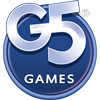“We are not your typical video game developers,” says David Condolora, the programmer and sound designer of the Brain&Brain, company of two. When David and his wife Brooke (artist and animator) set out to make their first game Doggins, their day jobs had seemingly nothing to do with game development; David was an assistant editor who worked on blockbuster animated films, and Brooke was a graphic designer with a lot of web design experience. “We had no idea what we were doing, but the one thing we did have was naiveté. So when I sent Brooke a message from my desk at work that said ‘You and me are going to make a game,’ her response was simply ‘Okay!'” David recalls as he shares the story of creating Doggins and teaming up with his wife under the name of Brain&Brain.
When Gamers Become a Family
Before I even knew the term “adventure game,” the worlds of Myst and Monkey Island absorbed and inspired me. I grew up exploring those worlds and solving their riddles, usually alongside my sister. We’d make smoothies together and then run upstairs to play on our old CRT monitor. The adventures I had prompted me to create worlds of my own, worlds meticulously mapped in my notebook and brought to life via computer graphics.

Hundreds of miles away, Brooke was exploring worlds of her own. The open-ended environments of the Zelda games were her playground, and she giddily probed their depths. When were were dating, I introduced her to The Curse of Monkey Island, and we’ve been playing adventure games together ever since, from Day of the Tentacle to Kentucky Route Zero.
A Touch-Centric Adventure Game
It’s safe to say that we both love the genre: its stories, humor, and inventiveness. So when we set out to make Doggins, we naturally wanted to make an adventure game. But there were things that we wanted to leave behind. We had grown tired of dialogue trees; we wanted to completely eliminate the UI (or at least be as close to this as possible); and to make touch-centric puzzles that emphasized direct manipulation of the game world.
To that end, Doggins is a bit different from most adventure games. There is no dialogue, written or spoken. Almost all storytelling is done visually, through character animation, camera movement, and environment design. There is no on-screen UI. You do have an inventory, but you can’t see it unless you swipe the screen, which causes it to elegantly slide into view.

There are a few “item-combination” puzzles typical for adventure games, but most of the puzzles rely on interaction with the environment as if you were really there, swiping the screen to slide dresser drawers or tugging on a boot stuck to the ground by gum.

It’s a different approach, and we’re really happy with how it turned out. While not totally original, we feel like we’ve helped in a small way to push the genre in a new direction.
Right Brain/Left Brain
We may have had non-traditional jobs for game developers, but those atypical skills really helped shape Doggins. My background in animation editing meant that I had a lot of experience with sound design. In animation, as in a video game, you get nothing for free; every sound must be created, and that experience telling stories with sound helped bring our game to life. Working in editing also helped me pace our cutscenes as well as the overall game, and was even valuable when it came time to compress audio and video files for the game.

Brooke is a true artist: she draws, does block and letterpress printing, creates motion graphics, and even occasionally paints. All of these skills merged with her expertise in graphic design to give Doggins a clean, designed look, with touches of screen-printing and echoes of vintage science-fiction posters. And her unorthodox sense of humor ensured that everyone who plays our game laughs out loud at least once.

Of course, we were also forced to step outside of our established skill sets. I had taken some programming classes in college, but had never fully coded a game before. Brooke had read a couple of books about animation, but had never put her knowledge into practice. A few months into development, she had animated her first walk cycle and I had coded my first game engine. All the while, we were cheering each other on.


Events as Deadlines for Indies
We began our journey to the Moon and back in April 2012. Throughout our nearly two-year development cycle, I had a full-time job in the film industry, and for much of that time, Brooke had other work both independently and for clients. A typical week of production meant me rising at 6:00 every weekday morning to put an hour in on the game before heading off to my job, Brooke working throughout the day, and us working together on weekends at various coffee shops on our island in the San Francisco Bay. It was a fitful production schedule, full of stops, starts, and sprints.
It can be hard to stay motivated without a real deadline, so we decided early on to submit to the Independent Games Festival with whatever we could finish by the submission date. We ended up not being able to submit (a story in itself), but having that deadline forced us to press hard and make substantial progress. Throughout development, we continued to use festival submissions as milestones and deadlines, which made the project more tangible.

One of those festivals was the SXSW Gaming Expo, which we submitted to somewhat on a whim, as the entry was free. We were shocked and elated when we received a notification that we had been nominated for the inaugural SXSW Gamer’s Voice Award, and simultaneously terrified when we realized we were probably about six months from being done with Doggins. That festival ended up being our biggest motivation of all: we had to finish the game in time to release it at the festival. Anything else would be squandering a huge opportunity.

We talked through a rough plan and set to work. I started getting up at 5:30 a.m., working on the game over my lunch break, and putting in a couple of hours together with Brooke at night. Our weekends were completely given over to Doggins. Somehow, we crammed six months of work into about two, and finally submitted the game to Apple. We took a week off, and then feverishly prepared for the festival and flew to Austin.
When we made Doggins available on the first day of the Gaming Expo, we were even more shocked to see it on the front page of the App Store, in the “Best New Games” category. There was even a small Doggins banner on the “Games” page! We had wistfully talked about this possibility many times while walking our dog Oliver (the game’s inspiration) over the two-year development cycle, but always dismissed it as impossible. Yet there was our game on the front page.
The reviews came in, hundreds of players came by our booth (with many staying for up to an hour), and we had one of the best weekends of our lives.

Community and Videos are Critical
We’re really proud of Doggins, but there’s a lot that we want to do differently with our next game. First, we’d like to release on our own schedule. If we had been able to choose a release date, rather than rush to finish the game in time for a festival, we could have spent more time properly marketing the game prior to its release. We’ve learned that the first few weeks of a game’s release are by far the most important, and wish that we had been more prepared.

Second, next time we’d like to cultivate more of a community. While we had a social media presence, it was sporadic and light. Next time, we’d like to more consistently update our blog, be more active on Twitter, and in general, interact more with both developers and players. It’s critical to begin building a community for your game long before it’s released; they will be your strongest advocates when you eventually release your game to the public.


Finally, we’d like to use video more effectively. You would think that with a day job in animated films, I would have created a ton of videos for Doggins. But we were so busy developing the game that our trailers ended up being more of an afterthought. We would have liked to create more videos that focus on the characters and quirky nature of the game, as well as what the game itself plays like. Video games are a visual medium, and a moving one at that. Watching a video is the next best thing to actually playing the game.

Doggins began with a simple text message, and turned into an adventure that has yet to end. Brain&Brain has gone from husband-and-wife with separate jobs and worlds, to a game design team, traveling the country and watching people smile as they experience what we’ve created. It’s been challenging, exciting, and humbling. We can’t wait to do it all again, and are already in pre-production on our next game.
Doggins is currently on iOS (iPad and iPhone), with Android (Google Play, Amazon Appstore, and more) releasing on September 30th. Oliver, the inspiration for the game and the developers’ family pet, hasn’t let his newfound celebrity go to his head. He still enjoys eating, sleeping, and chasing villainous squirrels in the park. 🙂
Comments









